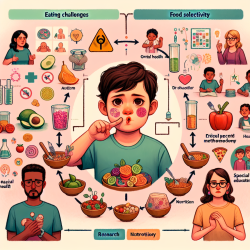Introduction
As a Special Education Director, understanding the diverse needs of our students is crucial. A recent study titled "Exploring Eating Challenges and Food Selectivity for Latinx Children with and without Autism Spectrum Disorder Using Qualitative Visual Methodology: Implications for Oral Health" offers valuable insights for practitioners working with Latinx children, both with and without Autism Spectrum Disorder (ASD). This research not only highlights the dietary challenges faced by these children but also underscores the importance of visual methodologies in understanding and addressing these challenges.
Understanding the Study
The study involved 32 Latinx caregivers from 18 families, who participated in a food journal activity and photo elicitation interviews. The research aimed to explore the differences in diet between Latinx children with and without ASD and how these differences impact oral health. By using visual methodologies, the study empowered caregivers to reflect on their children's eating habits and identify strategies to improve oral health outcomes.
Key Findings and Implications
- Empowerment through Visual Methodologies: The use of photo journaling allowed caregivers to become active participants in the research process. This empowerment led to increased awareness of dietary habits and their impact on oral health.
- Awareness of Sugar Consumption: Caregivers became more conscious of the sugar content in their children's diets, recognizing its negative impact on oral health. This awareness is crucial for developing strategies to reduce sugar intake.
- Food Selectivity in Children with ASD: The study confirmed that children with ASD exhibit higher food selectivity compared to their neurotypical peers. This selectivity often leads to nutritional inadequacies and poorer oral health outcomes.
Implementing Research Outcomes
For practitioners, the study offers several actionable insights:
- Incorporate visual methodologies in dietary assessments to engage caregivers and provide a comprehensive understanding of children's eating habits.
- Develop educational programs focused on reducing sugar intake and promoting healthier dietary choices among Latinx families.
- Address food selectivity in children with ASD by introducing new foods gradually and in a supportive environment.
Encouraging Further Research
This study highlights the need for further research into the dietary habits of underrepresented populations, such as Latinx children with ASD. By continuing to explore these areas, we can develop more effective interventions and support systems for families.
To read the original research paper, please follow this link: Exploring Eating Challenges and Food Selectivity for Latinx Children with and without Autism Spectrum Disorder Using Qualitative Visual Methodology: Implications for Oral Health.










